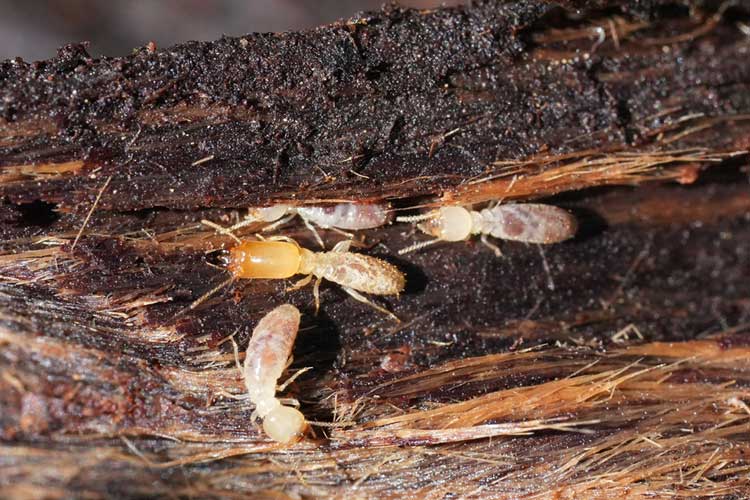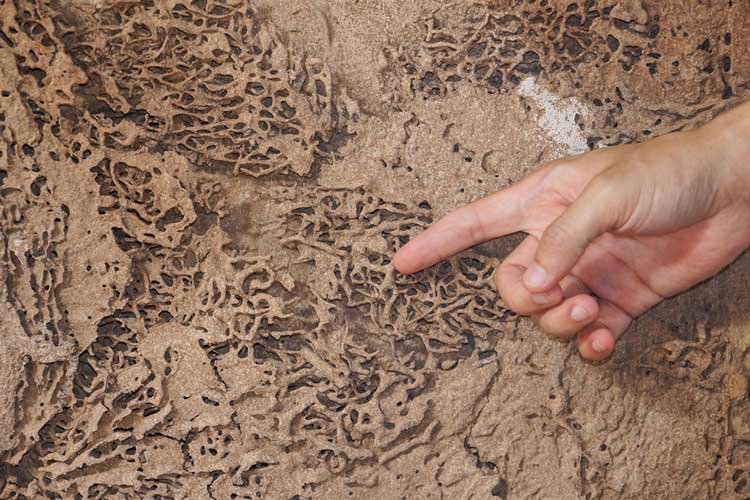How to Get Rid of Termites
Last updated November 2024

While an invasion of roaches or other bugs is merely unpleasant, termites can actually wreck the joint. Fortunately, the damage they cause spreads slowly, and you usually have lots of time to react before they do grave damage.
Termites live in colonies (workers, a queen, soldiers, etc.) and chow down on the cellulose in wood. Subterranean termites, the most common destructive type in this area, nest below ground, but the workers often travel above ground to gather food. They move through enclosed corridors either in wood or narrow mud tunnels that they construct up foundation walls to points of entry into wood.
You can spot termites in several ways: You may see reproductive “swarmers” in the spring, when they fly out to form new colonies; you may discover mud tunnels on your foundation walls or on exposed joists in your basement; or you may find their hollow tunnels in wood while tapping or probing with a screwdriver.
Most termites are white, with soft bodies and no wings, but their flying reproductives (“swarmers”) look a lot like flying ants. If you find an insect that you suspect is a termite, keep it and ask a competent professional to ID it.
How to Stop Them
Most pest control outfits offer two types of treatment plans for termite infestations.
Chemical Barriers
The traditional approach to termite treatment is creating a chemical barrier between the house and the soil. This usually means digging trenches around the foundation and pouring pesticide into them—or by pressure-injecting bug-killing stuff into the soil; it may be necessary to drill holes through the basement floor or into foundation wall voids.
The poisons now used to fight termites are both repellent (pyrethroids, such as permethrin and cypermethrin) and non-repellent insecticides (including imidacloprid and fipronil).
If your house has a large infestation, or has never before been treated for termites, the best strategy is to treat the entire home with a chemical barrier; then do spot treatments if new evidence of termites appears.
Baits Aren’t Better
Companies may suggest a bait system with traps placed every 10 or 15 feet around the structure’s perimeter. Then they periodically check them for signs of termite activity; if a problem is detected, they’ll replace the traps with baits containing slow-release growth regulators, which the termites will take back to their colony.
Used judiciously, baits can be an effective treatment. They limit pesticides released into the environment (chemical barriers can kill lots of beneficial insects), and baits are less disruptive than the trenching and drilling required to create a chemical barrier.
But some companies that sell bait systems often use unscrupulous tactics, putting out traps formulated to attract small numbers of termites and then using it as evidence to convince customers to sign up for expensive long-term treatment contracts.

Hiring Help
If you don’t have termites now, should you still hire a service? We believe the best way to save money and minimize pesticide usage is to not treat your house unless there is evidence of active infestation. The relatively minor damage likely to occur before an infestation is discovered—assuming you’re reasonably conscientious about inspection—does not justify the cost of treatment. (Still, preventive treatment during construction of a new house or an addition is a good idea.)
However, some companies we have surveyed believe preventive treatment is appropriate, at least for houses that have not been treated in a number of years, show no evidence of having been treated in the past, or are located in areas where termites are prevalent.
Be skeptical if a company discovers a termite problem and proposes treatment. Have it state—in writing—whether it has found evidence of active infestation. If so, obtain inspections and estimates from at least two additional companies before going ahead with treatment. Many homeowners who have had treatment recommended told us they later found that there was no active infestation. In some cases, the companies had shown evidence of termite damage but failed to explain that the infestation had been eliminated years earlier. When challenged, companies may claim that the treatment is preventive.
Because companies charge drastically different prices for the same termite jobs, get multiple proposals. To treat a small infestation, our undercover shoppers obtained prices ranging from less than $1,000 to more than $3,000.
Most companies provide a one-year guarantee against further infestation, a commitment to retreat if the bugs come back, and, sometimes, a commitment to repair any structural damage that occurs after the initial treatment. The company must also return to check your home a year after the treatment and whenever you detect termites. Many companies encourage you to pay an annual fee to extend your guarantee, typically 10 to 12 percent of the initial treatment charge, but some charge a fixed fee.
After you’ve received a complete professional treatment with a chemical barrier, keep the guarantee for two or three years. If annual inspections reveal no reinfestation during that period, you can be fairly confident that the treatment has been effective and avoid paying additional annual fees to extend your guarantee. Just take advantage of a company’s free inspection services every few years—or any time you see possible evidence of termite activity. New infestations can often be eliminated without treating the entire house.
If you are considering extending a guarantee, check the language carefully—price, required inspections, whether essential structural repairs are covered, and what you have to do to keep the guarantee in force.


